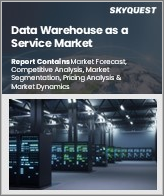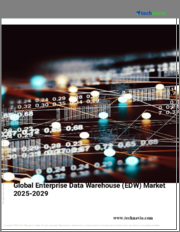
|
시장보고서
상품코드
1700058
세계의 기업 데이터 웨어하우스(EDW) 시장 : 배포 유형, 구성 요소, 데이터 유형, 기술, 용도, 최종 사용자, 지역별 예측 및 분석(-2032년)Enterprise Data Warehouse (EDW) Market Forecasts to 2032 - Global Analysis By Deployment Type (On-Premise, Cloud-Based and Hybrid), Component (Solutions and Services), Data Type, Technology, Application, End User and By Geography |
||||||
Stratistics MRC에 따르면 세계의 기업 데이터 웨어하우스(EDW) 시장은 2025년 279억 달러를 차지하고 예측 기간 동안 CAGR은 8.3%를 나타내며 2032년에는 487억 달러에 이를 전망입니다.
기업 데이터 웨어하우스(EDW)는 보고, 분석 및 의사결정을 위해 조직 전체의 여러 소스에서 데이터를 통합하는 중앙 집중식 리포지토리입니다. 종합적으로 파악하고 비즈니스 인텔리전스와 인사이트를 제공합니다. 복잡한 분석 및 데이터 마이닝 프로세스를 지원하며, 대부분의 경우 데이터 마트 및 기타 시스템과 통합됩니다.
통합된 데이터 뷰의 필요성
시장의 통합된 데이터 뷰는 조직의 모든 부서에서 일관되고 정확하고 시기적절한 인사이트를 확보하는 데 매우 중요합니다. 는 사일로를 제거하고 데이터 품질을 향상시키고 의사결정 프로세스를 간소화할 수 있습니다.
데이터 품질 및 거버넌스
시장에서의 데이터 품질 저하와 불충분한 거버넌스는 부정확한 인사이트, 의사결정 저하, 업무 비효율성으로 이어집니다. 또한 거버넌스의 부족은 보안 위험, 규정 준수 문제, 여러 플랫폼에 걸친 엄청난 데이터 관리의 어려움을 유발하여 결국 조직의 성장과 경쟁을 방해합니다.
기술 진보
시장의 기술 발전에는 클라우드 컴퓨팅, 인공지능 및 머신러닝 통합이 포함되어 있으며 실시간 데이터 처리, 애널리틱스 향상 및 자동화가 가능합니다. 비용 효율성을 제공하고 AI 중심의 애널리틱스는 의사결정 능력을 강화합니다. 또한 데이터 가상화와 멀티클라우드 전략의 대두는 조직이 다양한 플랫폼에서 방대한 양의 데이터를 보다 적절하게 관리하고 통합하는 데 도움이 됩니다.
보안 우려
시장의 보안 문제는 데이터 유출, 무단 액세스 및 기밀 정보의 손실로 이어질 수 있습니다. 취약한 보안 조치는 비즈니스 연속성을 방해하고 고객의 신뢰를 손상시키고 중요한 데이터를 사이버 공격에 노출시킬 수 있습니다.
COVID-19의 영향 :
COVID-19의 유행은 기업의 원격 근무과 디지털 업무로의 전환에 따라 클라우드의 기업 데이터 웨어하우스(EDW) 솔루션의 채용을 가속화했습니다. 하지만 수요가 높아졌지만, 데이터 보안, 거버넌스, 통합의 과제도 부각되었습니다.
예측기간 동안 관계형 데이터베이스 분야가 최대화될 전망
관계형 데이터베이스 영역은 구조화된 데이터 스토리지를 제공하고 일관성을 확보하며 효율적인 쿼리를 가능하게 함으로써 예측 기간 동안 최대 시장 점유율을 차지할 것으로 예상됩니다. 대규모 데이터 세트의 통합과 분석을 용이하게 합니다. 새로운 기술의 시작에도 불구하고 관계형 데이터베이스는 견고성, 확장성 및 기존 데이터 분석 도구와의 호환성으로 인해 여전히 EDW에 필수적이며 데이터 중심의 의사 결정으로 비즈니스를 지원합니다.
예측기간 동안 통신분야의 CAGR이 가장 높아질 전망
예측기간 동안 통신분야가 가장 높은 성장률을 보일 것으로 예측되고 있습니다. 는 효율적인 데이터 분석, 보고, 의사결정을 가능하게 하고 고객 경험, 네트워크 최적화, 업무 효율성을 향상시킵니다.
최대 점유율을 차지하는 지역
예측 기간 동안 북미가 가장 큰 시장 점유율을 차지할 것으로 예상됩니다. 디지털 전환에 대한 강한 주력, 실시간 통찰에 대한 수요 증가 등의 장점을 누리고 있습니다.
CAGR이 가장 높은 지역 :
예측 기간 동안 아시아태평양이 가장 높은 CAGR을 나타낼 것으로 예상됩니다. 또한, 중국이나 인도 등에서 급성장하고 있는 전자상거래 부문에서는 방대한 양의 데이터가 생성되기 때문에 견고한 데이터 웨어하우스 솔루션이 필요합니다.
무료 사용자 지정 오퍼링 :
이 보고서를 구독하는 고객은 다음 무료 맞춤설정 옵션 중 하나를 사용할 수 있습니다.
- 기업 프로파일
- 추가 시장 기업의 종합적 프로파일링(최대 3개사)
- 주요 기업의 SWOT 분석(최대 3개사)
- 지역 세분화
- 고객의 관심에 응한 주요국 시장 추계·예측·CAGR(주 : 타당성 확인에 따름)
- 경쟁 벤치마킹
- 제품 포트폴리오, 지리적 존재, 전략적 제휴에 기반한 주요 기업 벤치마킹
목차
제1장 주요 요약
제2장 서문
- 개요
- 이해관계자
- 조사 범위
- 조사 방법
- 데이터 마이닝
- 데이터 분석
- 데이터 검증
- 조사 접근
- 조사 자료
- 1차 조사 자료
- 2차 조사 정보원
- 전제조건
제3장 시장 동향 분석
- 성장 촉진요인
- 성장 억제요인
- 기회
- 위협
- 기술 분석
- 용도 분석
- 최종 사용자 분석
- 신흥 시장
- COVID-19의 영향
제4장 Porter's Five Forces 분석
- 공급기업의 협상력
- 구매자의 협상력
- 대체품의 위협
- 신규 참가업체의 위협
- 경쟁 기업간 경쟁 관계
제5장 세계의 기업 데이터 웨어하우스(EDW) 시장 : 배포 유형별
- 온프레미스
- 클라우드
- 하이브리드
제6장 세계의 기업 데이터 웨어하우스(EDW) 시장 : 구성 요소별
- 솔루션
- 데이터 웨어하우징 솔루션
- 데이터 통합 플랫폼
- 비즈니스 인텔리전스(BI) 도구
- 데이터 분석 도구
- 데이터 거버넌스 및 보안 솔루션
- 데이터 가상화 도구
- 서비스
- 컨설팅 서비스
- 구현 서비스
- 매니지드 서비스
- 지원 및 유지보수 서비스
- 교육 및 인증 서비스
- 데이터 마이그레이션 서비스
제7장 세계의 기업 데이터 웨어하우스(EDW) 시장 : 데이터 유형별
- 정형 데이터
- 비정형 데이터
- 반정형 데이터
제8장 세계의 기업 데이터 웨어하우스(EDW) 시장 : 기술별
- 관계형 데이터베이스
- 비관계형 데이터베이스
- 인메모리 데이터베이스
- 인공지능 및 머신러닝
- 기타 기술
제9장 세계의 기업 데이터 웨어하우스(EDW) 시장 : 용도별
- 비즈니스 인텔리전스(BI)
- 데이터 마이닝
- 데이터 통합
- 예측 분석
- 고객관계관리(CRM)
- 공급망 관리(SCM)
- 기타 용도
제10장 세계의 기업 데이터 웨어하우스(EDW) 시장 : 최종 사용자별
- 소매업 및 전자상거래
- 헬스케어 및 생명과학
- 은행, 금융서비스 및 보험(BFSI)
- 통신
- 제조
- 정부
- 기타 최종 사용자
제11장 세계의 기업 데이터 웨어하우스(EDW) 시장 : 지역별
- 북미
- 미국
- 캐나다
- 멕시코
- 유럽
- 독일
- 영국
- 이탈리아
- 프랑스
- 스페인
- 기타 유럽
- 아시아태평양
- 일본
- 중국
- 인도
- 호주
- 뉴질랜드
- 한국
- 기타 아시아태평양
- 남미
- 아르헨티나
- 브라질
- 칠레
- 기타 남미
- 중동 및 아프리카
- 사우디아라비아
- 아랍에미리트(UAE)
- 카타르
- 남아프리카
- 기타 중동 및 아프리카
제12장 주요 발전
- 계약, 파트너십, 협업, 합작투자
- 인수와 합병
- 신제품 발매
- 사업 확대
- 기타 주요 전략
제13장 기업 프로파일링
- Amazon
- Microsoft
- Snowflake
- Oracle
- IBM
- SAP
- Amazon Web Services(AWS)
- Teradata
- Informatica
- Talend
- Hitachi Vantara
- Firebolt
- MongoDB
- MemSQL
According to Stratistics MRC, the Global Enterprise Data Warehouse (EDW) Market is accounted for $27.9 billion in 2025 and is expected to reach $48.7 billion by 2032 growing at a CAGR of 8.3% during the forecast period. An Enterprise Data Warehouse (EDW) is a centralized repository that consolidates data from multiple sources across an organization for reporting, analysis, and decision-making. It stores historical and current data in a structured format, optimized for querying and reporting. EDWs provide a comprehensive view of an enterprise's operations, enabling business intelligence and insights. They support complex analytics and data mining processes, often integrating with data marts and other systems. EDWs ensure data consistency, reliability, and security, serving as the backbone for strategic business intelligence across the organization.
Market Dynamics:
Driver:
Need for a unified data view
A unified data view in the market is crucial for organizations to ensure consistent, accurate, and timely insights across all departments. By integrating data from disparate sources into a single, cohesive repository, businesses can eliminate silos, enhance data quality, and streamline decision-making processes. This unified approach allows for more efficient analytics, reduces discrepancies, and enables real-time access to actionable information, fostering better business strategies, improved operational performance, and a competitive edge in the market.
Restraint:
Data quality and governance
Poor data quality and inadequate governance in the market can lead to inaccurate insights, impaired decision-making, and operational inefficiencies. Inconsistent or unreliable data may result in faulty analyses, which can harm business strategies and customer trust. Additionally, a lack of governance can cause security risks, compliance issues, and difficulty in managing vast amounts of data across multiple platforms, ultimately hindering organizational growth and competitiveness.
Opportunity:
Advancements in technology
Advancements in technology within the market include the integration of cloud computing, artificial intelligence, and machine learning, enabling real-time data processing, improved analytics, and automation. Cloud-based EDWs offer scalability, flexibility, and cost-efficiency, while AI-driven analytics enhance decision-making capabilities. Additionally, the rise of data virtualization and multi-cloud strategies helps organizations better manage and integrate vast amounts of data across diverse platforms.
Threat:
Security concerns
Security concerns in the market can lead to data breaches, unauthorized access, and loss of sensitive information. These vulnerabilities jeopardize compliance with regulations like GDPR and HIPAA, risking hefty fines and reputational damage. Additionally, weak security measures may disrupt business continuity, compromise customer trust, and expose critical data to cyberattacks. Inadequate protection can ultimately hinder the adoption of EDW solutions, limiting their potential benefits for organizations.
Covid-19 Impact:
The COVID-19 pandemic accelerated the adoption of cloud-based Enterprise Data Warehouse (EDW) solutions as businesses shifted to remote work and digital operations. This surge in data generation increased the demand for scalable, flexible data management systems. However, it also highlighted challenges in data security, governance, and integration. Companies prioritized real-time analytics and decision-making to navigate uncertainties, driving further innovation and investment in EDW technologies for improved resilience and adaptability.
The relational databases segment is expected to be the largest during the forecast period
The relational databases segment is expected to account for the largest market share during the forecast period by providing structured data storage, ensuring consistency, and enabling efficient querying. They offer reliable data management with well-defined schemas, making it easier to integrate and analyze large datasets. Despite the rise of newer technologies, relational databases remain integral to EDWs due to their robustness, scalability, and compatibility with traditional data analytics tools, supporting businesses in data-driven decision-making.
The telecommunications segment is expected to have the highest CAGR during the forecast period
Over the forecast period, the telecommunications segment is predicted to witness the highest growth rate. With the growing demand for real-time data processing, telecom companies leverage EDW systems to consolidate vast amounts of customer, operational, and network data. These systems enable efficient data analytics, reporting, and decision-making, enhancing customer experience, network optimization, and operational efficiency. As telecom services expand globally, the demand for scalable, secure EDW solutions continues to rise.
Region with largest share:
During the forecast period, the North America region is expected to hold the largest market share. Companies across various sectors, including finance, healthcare, and retail, are adopting EDW solutions to improve data integration, reporting, and decision-making. The region benefits from robust technological infrastructure, a strong focus on digital transformation, and growing demand for real-time insights. North America's EDW market is expected to expand further as businesses seek scalable and efficient data management systems.
Region with highest CAGR:
Over the forecast period, the Asia Pacific region is anticipated to exhibit the highest CAGR. Businesses are increasingly adopting EDW solutions to enhance operational efficiency and gain competitive advantages through data analytics. Innovations in cloud computing, big data analytics, and artificial intelligence are propelling the adoption of EDW solutions. Additionally, the burgeoning e-commerce sector in countries like China and India generates vast amounts of data, necessitating robust data warehousing solutions.
Key players in the market
Some of the key players in Enterprise Data Warehouse (EDW) Market include Amazon, Google, Microsoft, Snowflake, Oracle, IBM , SAP, Teradata, Informatica, Talend, Hitachi Vantara, Firebolt, MongoDB and MemSQL.
Key Developments:
In February 2025, Amazon and the Directorate General of Foreign Trade (DGFT) have announced an extension of their collaboration, first formalised in November 2023, to accelerate ecommerce exports from India. Building on their initial Memorandum of Understanding, the renewed association covers specialised training sessions across 47 districts, integration of Amazon's Export Navigator tool within DGFT's Trade Connect portal, and the establishment of Expert Communities as local offline networks for MSMEs.
In February 2025, Salesforce and Google announced a major expansion of their strategic partnership, delivering choice in the models and capabilities businesses use to build and deploy AI-powered agents. In today's constantly evolving AI landscape, innovations like autonomous agents are emerging so quickly that businesses struggle to keep pace.
Deployment Types Covered:
- On-Premise
- Cloud-Based
- Hybrid
Components Covered:
- Solutions
- Services
Data Types Covered:
- Structured Data
- Unstructured Data
- Semi-Structured Data
Technologies Covered:
- Relational Databases
- Non-Relational Databases
- In-Memory Databases
- Artificial Intelligence and Machine Learning
- Other Technologies
Applications Covered:
- Business Intelligence (BI)
- Data Mining
- Data Integration
- Predictive Analytics
- Customer Relationship Management (CRM)
- Supply Chain Management (SCM)
- Other Applications
End Users Covered:
- Retail and E-commerce
- Healthcare and Life Sciences
- Banking, Financial Services, and Insurance (BFSI)
- Telecommunications
- Manufacturing
- Government
- Other End Users
Regions Covered:
- North America
- US
- Canada
- Mexico
- Europe
- Germany
- UK
- Italy
- France
- Spain
- Rest of Europe
- Asia Pacific
- Japan
- China
- India
- Australia
- New Zealand
- South Korea
- Rest of Asia Pacific
- South America
- Argentina
- Brazil
- Chile
- Rest of South America
- Middle East & Africa
- Saudi Arabia
- UAE
- Qatar
- South Africa
- Rest of Middle East & Africa
What our report offers:
- Market share assessments for the regional and country-level segments
- Strategic recommendations for the new entrants
- Covers Market data for the years 2024, 2025, 2026, 2028, and 2032
- Market Trends (Drivers, Constraints, Opportunities, Threats, Challenges, Investment Opportunities, and recommendations)
- Strategic recommendations in key business segments based on the market estimations
- Competitive landscaping mapping the key common trends
- Company profiling with detailed strategies, financials, and recent developments
- Supply chain trends mapping the latest technological advancements
Free Customization Offerings:
All the customers of this report will be entitled to receive one of the following free customization options:
- Company Profiling
- Comprehensive profiling of additional market players (up to 3)
- SWOT Analysis of key players (up to 3)
- Regional Segmentation
- Market estimations, Forecasts and CAGR of any prominent country as per the client's interest (Note: Depends on feasibility check)
- Competitive Benchmarking
- Benchmarking of key players based on product portfolio, geographical presence, and strategic alliances
Table of Contents
1 Executive Summary
2 Preface
- 2.1 Abstract
- 2.2 Stake Holders
- 2.3 Research Scope
- 2.4 Research Methodology
- 2.4.1 Data Mining
- 2.4.2 Data Analysis
- 2.4.3 Data Validation
- 2.4.4 Research Approach
- 2.5 Research Sources
- 2.5.1 Primary Research Sources
- 2.5.2 Secondary Research Sources
- 2.5.3 Assumptions
3 Market Trend Analysis
- 3.1 Introduction
- 3.2 Drivers
- 3.3 Restraints
- 3.4 Opportunities
- 3.5 Threats
- 3.6 Technology Analysis
- 3.7 Application Analysis
- 3.8 End User Analysis
- 3.9 Emerging Markets
- 3.10 Impact of Covid-19
4 Porters Five Force Analysis
- 4.1 Bargaining power of suppliers
- 4.2 Bargaining power of buyers
- 4.3 Threat of substitutes
- 4.4 Threat of new entrants
- 4.5 Competitive rivalry
5 Global Enterprise Data Warehouse (EDW) Market, By Deployment Type
- 5.1 Introduction
- 5.2 On-Premise
- 5.3 Cloud-Based
- 5.4 Hybrid
6 Global Enterprise Data Warehouse (EDW) Market, By Component
- 6.1 Introduction
- 6.2 Solutions
- 6.2.1 Data Warehousing Solutions
- 6.2.2 Data Integration Platforms
- 6.2.3 Business Intelligence (BI) Tools
- 6.2.4 Data Analytics Tools
- 6.2.5 Data Governance & Security Solutions
- 6.2.6 Data Virtualization Tools
- 6.3 Services
- 6.3.1 Consulting Services
- 6.3.2 Implementation Services
- 6.3.3 Managed Services
- 6.3.4 Support and Maintenance Services
- 6.3.5 Training and Certification Services
- 6.3.6 Data Migration Services
7 Global Enterprise Data Warehouse (EDW) Market, By Data Type
- 7.1 Introduction
- 7.2 Structured Data
- 7.3 Unstructured Data
- 7.4 Semi-Structured Data
8 Global Enterprise Data Warehouse (EDW) Market, By Technology
- 8.1 Introduction
- 8.2 Relational Databases
- 8.3 Non-Relational Databases
- 8.4 In-Memory Databases
- 8.5 Artificial Intelligence and Machine Learning
- 8.6 Other Technologies
9 Global Enterprise Data Warehouse (EDW) Market, By Application
- 9.1 Introduction
- 9.2 Business Intelligence (BI)
- 9.3 Data Mining
- 9.4 Data Integration
- 9.5 Predictive Analytics
- 9.6 Customer Relationship Management (CRM)
- 9.7 Supply Chain Management (SCM)
- 9.9 Other Applications
10 Global Enterprise Data Warehouse (EDW) Market, By End User
- 10.1 Introduction
- 10.2 Retail and E-commerce
- 10.3 Healthcare and Life Sciences
- 10.4 Banking, Financial Services, and Insurance (BFSI)
- 10.5 Telecommunications
- 10.6 Manufacturing
- 10.7 Government
- 10.8 Other End Users
11 Global Enterprise Data Warehouse (EDW) Market, By Geography
- 11.1 Introduction
- 11.2 North America
- 11.2.1 US
- 11.2.2 Canada
- 11.2.3 Mexico
- 11.3 Europe
- 11.3.1 Germany
- 11.3.2 UK
- 11.3.3 Italy
- 11.3.4 France
- 11.3.5 Spain
- 11.3.6 Rest of Europe
- 11.4 Asia Pacific
- 11.4.1 Japan
- 11.4.2 China
- 11.4.3 India
- 11.4.4 Australia
- 11.4.5 New Zealand
- 11.4.6 South Korea
- 11.4.7 Rest of Asia Pacific
- 11.5 South America
- 11.5.1 Argentina
- 11.5.2 Brazil
- 11.5.3 Chile
- 11.5.4 Rest of South America
- 11.6 Middle East & Africa
- 11.6.1 Saudi Arabia
- 11.6.2 UAE
- 11.6.3 Qatar
- 11.6.4 South Africa
- 11.6.5 Rest of Middle East & Africa
12 Key Developments
- 12.1 Agreements, Partnerships, Collaborations and Joint Ventures
- 12.2 Acquisitions & Mergers
- 12.3 New Product Launch
- 12.4 Expansions
- 12.5 Other Key Strategies
13 Company Profiling
- 13.1 Amazon
- 13.2 Google
- 13.3 Microsoft
- 13.4 Snowflake
- 13.5 Oracle
- 13.6 IBM
- 13.7 SAP
- 13.8 Amazon Web Services (AWS)
- 13.9 Teradata
- 13.10 Informatica
- 13.13 Talend
- 13.12 Hitachi Vantara
- 13.13 Firebolt
- 13.14 MongoDB
- 13.15 MemSQL



















